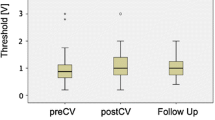Abstract
Internal electrical cardioversion is currently used in patients with persistent atrial fibrillation resistant to external electrical cardioversion. In external cardioversion, biphasic waveforms have shown a greater efficacy than monomorphic waveforms. The present study aimed to test the safety and efficacy of rectilinear biphasic waveform in converting patients with persistent atrial fibrillation to sinus rhythm using internal electrical cardioversion, and to compare it with that of classical monophasic waveform. Twenty-seven consecutive patients with persistent AF received 31 internal cardioversions, using monophasic waveform in 11 (group I), and rectilinear biphasic waveform in 20 cases (group II). Baseline patients characteristics were similar in both groups. Multipolar catheters were positioned in the distal coronary sinus and in the high right atrium. Synchronised shocks were delivered using an escalating protocol of 2, 5, 10, 15, 20, 30, and 50 Joules. In group I, 1 patient was resistant to maximal energy (success rate 91%). The mean energy of the maximal shock was 18 ± 13 J. In group II, all patients were converted to sinus rhythm. The mean energy of the maximal shock was 9 ± 5 J (p < 0.01 vs. group I). No significant complications occurred. At 3 months follow-up, 45% of group I and 60% of group II patients remained in sinus rhythm (p = NS).
We conclude that internal cardioversion using rectilinear biphasic waveform is feasible and safe, and requires less energy than classical monophasic waveforms.
Similar content being viewed by others
References
Furster V, Ryden LE, Asinger RW, et al. ACC/AHA/ESC Guidelines for the management of patients with atrial fibrillation: Executive summary. Circulation 2001;104:2118–2150.
Lown B, Perloth MG, Kaidbe S, Abe T, Harken DW. «Cardioversion » of atrial fibrillation: A report on the treatment of 65 episodes in 50 patients. N Engl J Med 1963;269:325–331.
Dell'Orfano JT, Nacarelli GV. Update on external cardioversion and defibrillation. Curr Opin Cardiol 2001;16:54–57.
Ricard P, Levy S, Boccara G, Lakhal E, Bardy G. External cardioversion of atrial fibrillation: comparison of biphasic vs. monophasic waveform shocks. Europace 2001;3:96–99.
Levy S, Lauribe P, Dolla E, et al. A randomized comparison of external and internal cardioversion of chronic atrial fibrillation. Circulation 1992;86:1415–1420.
Levy S, Ricard P, Lau CP, et al. Multicenter low–energy transvenous atrial defibrillation trial results in different subsets of atrial fibrillation. J Am Coll Cardiol 1997;29:750–755.
Sopher SM, Murgatroyd FD, Slade AKB, et al. Low energy internal cardioversion of atrial fibrillation resistant to transthoracic shocks. Heart 1996;75:635–638.
Schmitt C, Alt E, Plewan A, et al. Low energy intracardiac cardioversion after failed conventional external cardioversion of atrial fibrillation. J Am Coll Cardiol 1996;28:994–999.
Neri R, Palermo P, Cesario AS, Baragli D, Amici E, Gambelli G. Internal cardioversion of chronic atrial fibrillation in patients. PACE 1997;20:2237–2242.
Blommaert D, De Roy L, Adam JF, Jamart J, Mucimbitsi J. Limited internal shocks for atrial fibrillation refractory to external cardioversion. International Journal of Cardiology 1999;71:71–78.
Taramasco V, Socas A, Ricard P, Levy S. Internal low–energy cardioversion: A therapeutic option for restoring sinus rhytm in chronic atrial fibrillation after failure of external cardioversion. Europace 1999;1:179–182.
Boriani G, Biffi M, Camanini C, Luceri RM, Branzi A. Transvenous low energy internal cardioversion for atrial fibrillation. PACE 2001;24:99–107.
Andraghetti A, Scalese M. Safety and efficacy of lowenergy cardioversion of 500 patients using two different techniques. Europace 2001;3:4–9.
Paravolidakis KE, Kolettis TM, Theodorakis GN, Paraskevaidis IA, Apostolou TS, Kremastinos DTh. Prospective randomized trial of external versus internal transcatheter cardioversion in patients with chronic atrial fibrillation. J Interventional Cardiac Electrophysiol 1998;2:249–253.
Mittal S, Ayati S, Stein KM. Comparison of a novel rectilinear biphasic waveform with a damped sine monomorphic waveform for transthoracic ventricular defibrillation. J AmColl Cardiol 1999;34:1595–1601.
Mittal S, Ayati S, Stein KM. Transthoracic cardioversion of atrial fibrillation. Comparison of rectilinear biphasic versus damped sine wave monophasic shocks. Circulation 2000;101:1282–1287.
Tang W, Weil MH, Sun S, et al. The effects of biphasic and conventional monophasic defibrillation on postresuscitation myocardial function. J Am Coll Cardiol 1999;34: 815–822.
Timmerman C, Rodriguez LM, Smeets JLRM, Wellens HJJ. Immediate reinitiation of atrial fibrillation following internal atrial defibrillation. J Cardiovasc Electrophysiol 1998;9:122–128.
Author information
Authors and Affiliations
Corresponding author
Rights and permissions
About this article
Cite this article
Mairesse, G.H., Raepers, M., Legrand, I. et al. Internal Cardioversion of Persistent Atrial Fibrillation Using Rectilinear Biphasic Waveform. J Interv Card Electrophysiol 9, 371–375 (2003). https://doi.org/10.1023/A:1027403729049
Issue Date:
DOI: https://doi.org/10.1023/A:1027403729049




